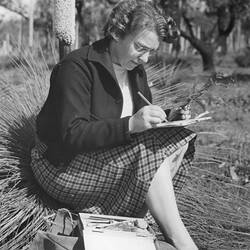Summary
Colour photograph of teaching staff at Sacred Heart College, Shepparton. Hope Macpherson was employed by Sacred Heart College, Knight Street, Shepparton from commencement of the 1977 school year on a full time basis teaching 74 periods out of 80 per fortnight for an annual salary of $9,115.
Hope was the first female curator at National Museum of Victoria (now Museum Victoria). Hope along with Isobel Bennett, Susan Ingham and Mary Gillham were the first women to visit the Antarctic in their December 1959 expedition. Following her marriage in 1965, Hope had to resign from her position with the museum in accordance with the limitations placed on the employment of married women at that time.
Description of Content
Colour photograph of 31 teachers arranged in four rows, with first row seated, remainder standing. Hope Macpherson is in second row, third person from left wearing brown cardigan over tan skivvy and glasses. Photograph mounted in printed white folder.
Physical Description
Colour photograph.
Significance
The Hope (Macpherson) Black Collection is a significant addition to Museum Victoria's working lives collection, it reveals the journey of a woman from depression era Melbourne and illustrates the power of education. It also reveals the often discriminatory policies in place in Victoria before the equal opportunity developments of the late 20th century. In balance though it also exposes the somewhat free expression possible for empowered women in this period. Hope Macpherson clearly states that in her day to day work she never felt discrimination and believes she was given great opportunity to pursue her career and aspirations. However, on analysis her role was often shaped by her gender and its perceived strengths and weaknesses; she was dissuaded from applying to become a taxidermist as it was 'an unsuitable job for a woman', although part of the first group of female scientists allowed to travel to Macquarie Island they were not permitted to camp on land with the male crew for fear of inciting passions. And finally after a distinguished career she was forced to resign her tenure as Australia's first female Curator when she married late in life, as a consequence of the Marriage bar.
More Information
-
Collection Names
-
Collecting Areas
-
Acquisition Information
Donation from Hope Black (nee Macpherson), Apr 2011
-
Person Depicted
Miss Hope Macpherson - National Museum of Victoria, Shepparton, Victoria, Australia, circa 1977
-
Format
Photograph, Colour
-
Inscriptions
'Memories' printed two colour on front. 'Fotek School Portraits Pty Ltd' plus addresses and telephone numbers for branches in NSW, SA, Qld, Tas, WA and Vic, printed two colour on back.
-
Classification
-
Category
-
Discipline
-
Type of item
-
Image Dimensions - Photograph
178 mm (Width), 126 mm (Height)
-
Keywords

